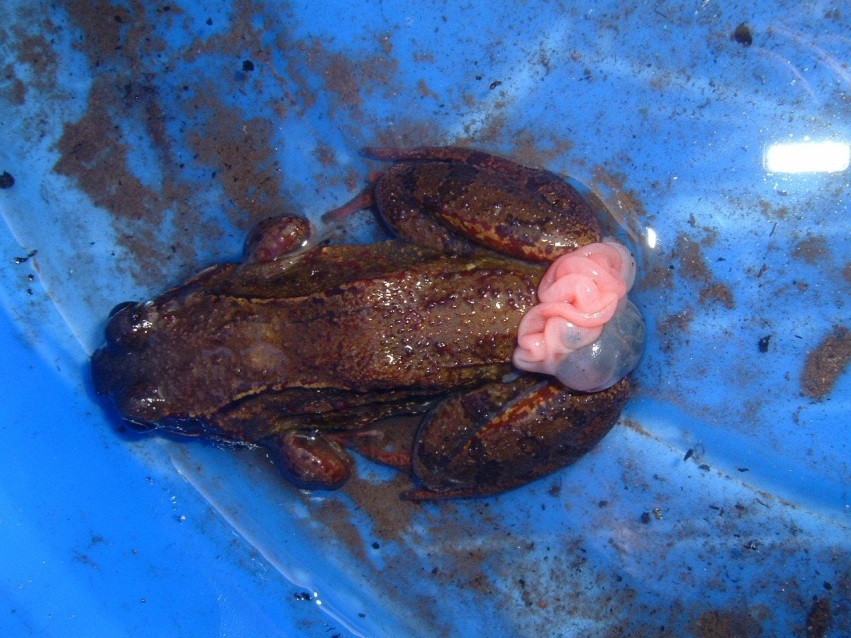Agent
Prolapse involves the displacement and protrusion of a body tissue from its normal location. In amphibians, prolapse of tissues may occur through the cloaca (posterior opening), mouth or through a wound. Amphibian cloacal prolapse involves organs such as the bladder, intestines and uterus which may be seen protruding from the cloaca. Amplexus, the mating embrace that amphibians perform, can be a cause of prolapse due to the increased pressure applied to the body. Other possible causes of prolapse include nutritional deficiencies, gastrointestinal obstructions, parasites and pollutant exposure. The relative importance of these as a cause of amphibian prolapse in Great Britain is unknown.
Species affected
In Great Britain, amphibian prolapse is reported rarely but sometimes may be detected in clusters. This syndrome tends to be more common in anurans (frogs and toads) than in caudates (newts). Species known to have been affected in Great Britain include the common frog (Rana temporaria) and the common toad (Bufo bufo).
Signs of disease
Amphibian prolapse usually involves the protrusion of tissues from the cloaca, mouth or from a wound (e.g. see Figure 1). Cloacal prolapse is most common, however gastric prolapse may occur whereby tissues are seen protruding from the mouth. In addition, after trauma, tissues may be seen protruding from a wound. Often amphibians will appear bright and alert despite the prolapse.
Figure 1. Common frog (Rana temporaria) with a cloacal prolapse. (Photo credit: L Gerrish)
Disease transmission
There is no single recognised cause of amphibian prolapse.
Distribution
In Great Britain, reports of amphibian prolapse are sporadic however there are often an increased number of reports during the breeding season. The condition usually affects only individuals or small numbers of animals at any one time.
Risk to human health
No known risk to human health.
Risk to domestic animal health
No known risk to domestic animal health.
Diagnosis
Amphibian prolapse is often easy to diagnose due to the obvious appearance, but it can be difficult to determine which tissue has prolapsed (e.g. reproductive or intestinal tract).
Diagnosing the definitive cause of an amphibian prolapse can be very difficult because this condition can occur due to a variety of reasons. In addition, by the time an affected animal is found, the cause of the prolapse might have disappeared. However, specific factors can be used to help diagnose the cause of prolapse. For example, if an amphibian presents with a cloacal prolapse during the spring breeding season, it is more likely that amplexus was the cause of the condition. Alternatively, if tissues are seen protruding from the skin on the back, trauma, possibly due to predation, would be the most likely cause.
If you wish to report finding a dead amphibian, or signs of disease in amphibians, please visit www.gardenwildlifehealth.org. Alternatively, if you have further queries or have no internet access, please call the Garden Wildlife Health vets on 0207 449 6685.
Control and prevention
Small prolapses often spontaneously resolve and this process may be helped by keeping animals in water to prevent drying of the tissues. Large prolapses or ones which do not resolve may need veterinary attention.
Further information
Phillott AD and Young S (2009) Occurrence of cloacal prolapse in wild hylids in the Wet Tropics, Australia. Diseases of Aquatic Organisms 86:77-80. doi.org/10.3354/dao02097
Wright KM (2001) Idiopathic syndromes. In: Wright and Whitaker (eds) Amphibian medicine and captive husbandry. Krieger Publishing Company, Malabar, FL, p 239–244.
Acknowledgements
Current funding for the GWH comes in part from Defra, the Welsh Government and the Animal and Plant Agency (APHA) Diseases of Wildlife Scheme (DoWS) http://apha.defra.gov.uk/vet-gateway/surveillance/seg/wildlife.htm; and from the Esmée Fairbairn Foundation, the Universities Federation for Animal Welfare and the Garfield Weston Foundation.
Disclaimer
This fact sheet was produced by Garden Wildlife Health (GWH) for information purposes only. The GWH will not be liable for any loss, damage, cost or expense incurred in or arising by reason of any person relying on information in this fact sheet.
Date of factsheet update:
April 2020

